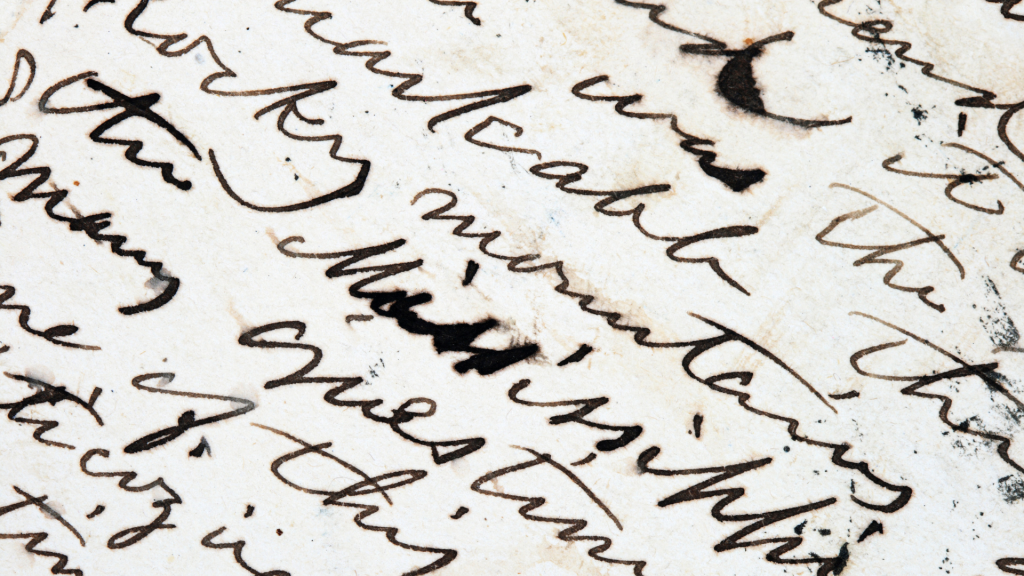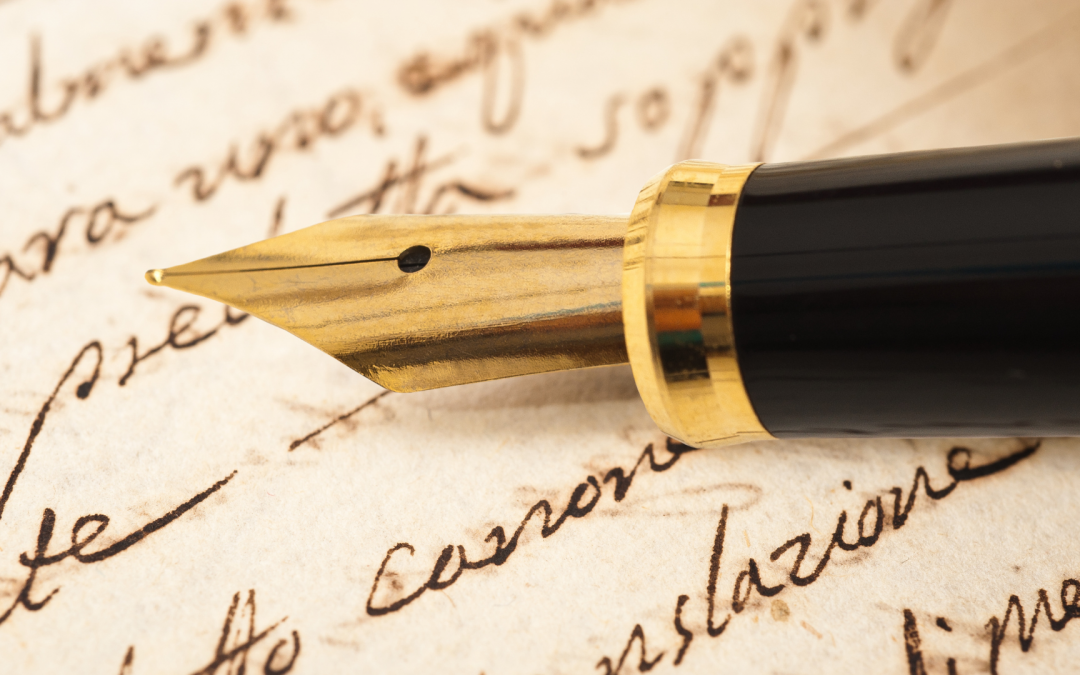A couple of years ago I had to take an exam, first one in my years. The most gruelling aspect of the exam was not the revising, the reading or the note taking – it was the method.
I would have to write. By hand. Pen and paper. For two hours.
That’s what I had to practice most of all, to revive those muscles that have atrophied since I left school.
My handwriting had gone to pot. I started practising again with a fountain pen, which acted as a form of control, but resorted to a plain old ball-point by the end for efficiency’s sake. (And to avoid any inkblot related mishaps against the clock.)
Shame, I thought, to have lost such a skill.
Shame to be excluded from a world of panache and sophistication.
Because signing a letter (or a contract) with the flourish of fountain pen has a sense of majesty about it. Autographing a book (preferably your own) with a crafted nib adds to that sense of occasion and achievement.
Pen and paper carries the weight of tradition
Pen and paper is a classic tradition. With a fountain pen in your hand, and new notebook open on the first page, the giants of literature sit on your shoulder, wishing you well.
There’s something special about writing with pen and ink. The tactile sensation of the pen gliding across the page, the rich, deep colour of the ink. It’s a timeless and elegant way to put your thoughts on paper.
- How the greatest love story in history has a tragic modern feel
- How to find a compelling voice: stunning advice from a master story-teller
It is so rich in tradition that it might change the texture of what you write. The lack of “editing feature” means you have to think before you commit to a word or phrase. And the ponderous progress means there is more “thought per word” and more weight per sentence.
The close connection between penmanship and personality (graphology) suggests a kinship, a spiritual bond, that goes beyond the words on the page, slapped there via a Bluetooth keyboard.
Five benefits of writing by hand
- Improved handwriting: Writing with a pen can improve your handwriting because it requires physical effort to form each letter, which can help develop fine motor skills.
- Greater focus and concentration: Using a pen can help you focus and concentrate on your writing because it requires more attention than typing on a computer.
- Better memory retention: Studies have shown that writing by hand can help improve memory retention and recall, possibly because the physical act of writing involves more senses and cognitive processes than typing on a computer.
- Increased creativity: Some people find that they are more creative when they write by hand, as it allows them to brainstorm and jot down ideas in a more fluid and organic way.
- Greater sense of accomplishment: There is a sense of satisfaction that comes with physically completing a written task, such as completing a handwritten letter or journal entry. This can provide a sense of accomplishment and can be motivating to keep writing.
Capturing the act of writing
Every couple of years, I wash out my old fountain pen, fill it with Quink and go again, thinking it a rarefied art and stamp of someone with a degree of prestige and authority.
Once I even tried to write a book with a fountain pen. I imagined my notebooks being snapped up at auction by the British Library, their experts feverish to understand the evolution of my story through the crossings out and marginalia.

(Handwritten notes from Charles Dickens can go for thousands, even tens of thousands, by the way.)
For me, it felt great. But it was a right old mess.
Every few years I read stories in the press about how fountain pen sales are holding up against the tide of technology.
They have become, like wrist watches, resilient symbols rather than necessary tools. Like books, too, they are works of finesse and pleasure in themselves regardless of the images they conjure in action. Fountain pens can be beautiful and beautifully crafted, surely a boon to anyone looking to make great art.
Pen and paper changes the way you think about writing
The great fiction writer Neil Gaiman had some of these epiphanies when he reached for his pen.
He told Buzzfeed:
“I started with Stardust: It was (in my head) being written in the 1920s, so I bought a fountain pen and a big notebook and wrote it by hand to find out how writing by hand changed my head.
“And it did, it really did. I was sparser, I would think my way through a sentence further, I would write less, in a good way. And when I typed it up, it became a very real second draft — things would vanish or change. I discovered that I enjoyed messing about with fountain pens, I even liked the scritchy noise the pen nib made on the paper.
“So I kept doing it. Sandman: Dream Hunters and American Gods and Anansi Boys and The Graveyard Book were all written by hand. The last two-thirds of Coraline was also written by hand.”
Five tips to improve your handwriting
- Use the right writing implement: Choose a pen or pencil that feels comfortable to hold and write with. Some people prefer thicker pens with a softer tip, while others prefer a finer tip for more precise writing. Experiment with different options to find what works best for you.
- Practice regularly: The more you write, the more comfortable and confident you will become with your handwriting. Consider setting aside time each day to practice your penmanship, whether it’s by writing a letter, journaling, or completing a handwriting exercise.
- Pay attention to posture and grip: Good posture and a proper grip on your writing implement can help improve your handwriting. Sit up straight and hold your pen or pencil with a relaxed grip, using your thumb and index finger to guide it.
- Use the right paper: Choose paper that is smooth and of a good weight for your writing implement. Avoid using paper that is too thin or too thick, as it can be difficult to write on.
- Pay attention to form: Pay attention to the form of each letter as you write, focusing on making consistent and even strokes. Some people find it helpful to use guides, such as lined paper or a handwriting worksheet, to help them practice proper letter formation.
Five authors who write by hand

- JK Rowling: The famous author of the Harry Potter series is known to have written the first book in the series, Harry Potter and the Philosopher’s Stone, by hand. She says that she particularly likes plotting and writing first drafts by hand.
- Margaret Atwood: The award-winning author and poet is known to prefer writing by hand, as she finds it easier to revise and edit her work in this way.
- John Steinbeck: The Pulitzer Prize-winning author wrote many of his works, including “The Grapes of Wrath” and “Of Mice and Men,” by hand.
- Ernest Hemingway: The Nobel Prize winner carried a notebook and pencil in his pocket so he could write anywhere he was. He once said, “Wearing down seven number-two pencils is a good day’s work.”
- Toni Morrison: The Nobel Prize-winning author and editor is known to have written some of her works, including Beloved, by hand. Writing poetry by hand seems natural – there’s a closer focus on individual words – and there’s fewer of them than in a sci-fi blockbuster.
How much does a fountain pen cost?
“We’d say the average amount should be between £80 and £400,” says gadget site T3. “This will buy you a luxury writing implement that will last years and years of loyal service.”
But you can start off in teens of pounds at the local stationery store and then the sky’s the limit.
The Nakaya Cigar Makie Seiohbo Fountain Pen, for example, costs £42,840 for example. And you still have to buy the ink.
What to look out for in a fountain pen
- Smooth writing: A good fountain pen should have a smooth writing experience, with the ink flowing consistently and evenly onto the page.
- Comfortable grip: The grip of a fountain pen should be comfortable and easy to hold for long periods of time, without causing fatigue or strain.
- High-quality materials: A good fountain pen should be made from high-quality materials, such as durable metal or resin, to ensure it will last for a long time and provide a good writing experience.

